About this Blog: Kedarnath Yatra is one of the most spiritual pilgrimages in India. Kedarnath, the abode of Lord Shiva attracts thousands of devotees within a span of 6 months when the shrine remains open. Kedarnath is a part of the sacred Char Dhams (4 pilgrimages) as well as a part of the Panch Kedars. This blog is about our experience of the Kedarnath Trek done in the month of October. Read on to know more about Kedarnath Yatra, how to reach and where to stay and other related information.
Kedarnath is not just a place of pilgrimage for me. The place has much more significance. It was the first place that I had ever travelled with my family. I do hear every now and then that I had been a very difficult 2-year-old during that time who gave a tough time to my parents. Well, what else to expect from a toddler! Now after almost three decades, I was again ready for Kedarnath Yatra again with Agni in tow. Only this time, we decided to go on foot from Gaurikund and I was quite excited about the Kedarnath trek.
This trip was going to be a special one, not for a singular reason. To be honest, I was way too excited to visit a place that has such nostalgic memories for me. The moment we told our families about this trip, my father started telling me stories about “that” Kedarnath Yatra that happened almost 30 years ago. By stories, he meant all the embarrassing episodes of a two and a half-year-old on a trip with the family. It seemed he divulged all my idiotic secrets to my husband, who of course, did not forget to tease me later.
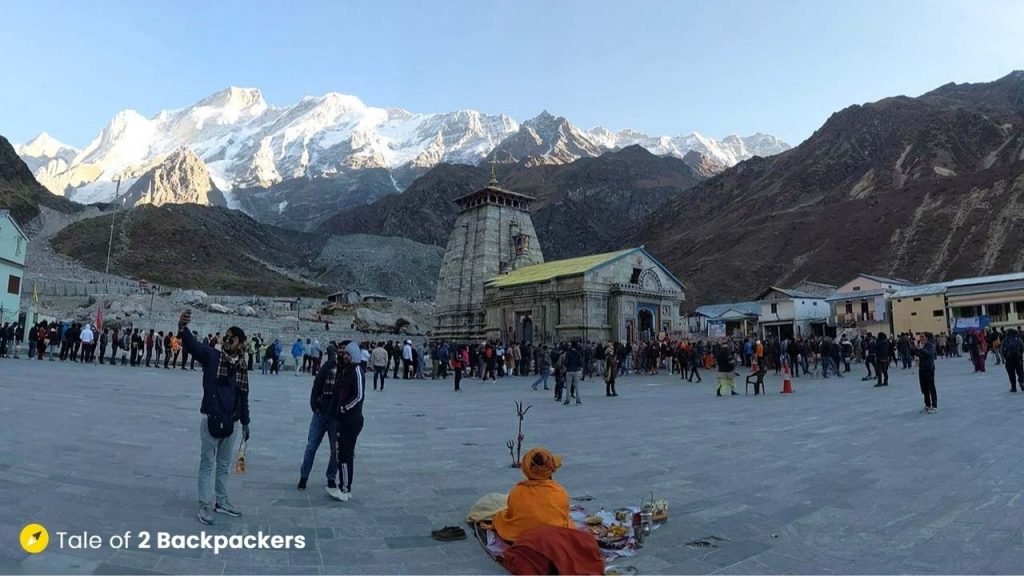
My uncle was quite excited to know we were visiting Kedarnath and Badrinath. He recalled all the special places and even told me to take pictures in the same pose as we had done previously. So much for changes! Overall, going to Kedarnath was exciting not only for us, but also for my family.
For Agni and me, Kedarnath trek was important because we were again trekking the Himalayan trails after almost 2 years. All these years, we had done a few short treks in the Western Ghats and the David Scott Trail in Meghalaya. We thought Kedarnath trek might be the catalyst that would overcome the drought in our trekking trips. After all, it was after Amarnath Yatra that we had fallen for trekking! So enough of my ramblings, let us start with all the information you wanted to know about Kedarnath Yatra, Kedarnath Temple and of course our amazing experience there.
Where is Kedarnath located?
Kedarnath Dham is a part of the Char Dhams Yatra (4 religious places) that also includes Gangotri, Yamunotri and Badrinath. Located in the Rudraprayag district of Garhwal region in Uttarakhand, the Kedarnath temple is located in the Kedar valley below the Chorabari glacier, which is the source of the river Mandakini.
Kedarnath – History, Legend and Stories
It is usually an obsession with me to find out about the past of any place that we visit, especially if the place happens to be a historical and religious place. For temples in India have numerous stories hidden in them. I did the same for Kedarnath.
It is believed that the Kedarnath shrine was buried under the snow for almost 400 years!
Like others, Kedarnath also has its fair share of mythologies and legends. There are various versions on the origin of the Kedarnath Temple. While there are claims that the temple was resurrected and built by the great Hindu seer Adi Shankaracharya in the 8th century while others claim that it was built by the Hindu King Raja Bhoj of Malwa in the 2nd century AD. Well, as I said before, there are numerous versions.
Kedarnath finds mention in the great Hindu epic Mahabharata and this is where the legend of Panch kedar comes in. Did I mention before that Kedarnath is also one of the five (Panch) Kedars, the five holy places of Lord Shiva.
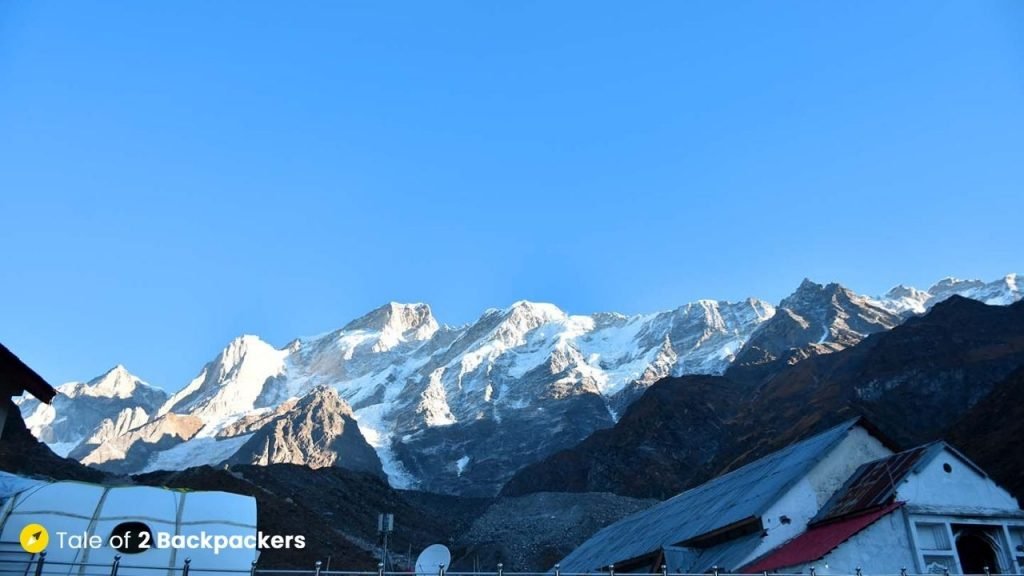
In the epic battle of Kurukshetra where the brothers fought against each other, the Pandavas defeated and killed their cousin brothers Kauravas. The Pandavas killed their own in the battle and were inflicted by self-remorse and guilt. They decided to ask for forgiveness from Lord Shiva, the master of the Universe. With this thought in mind, the Pandavas decided to go to Kashi to ask for forgiveness from God. Lord Shiva, on the other hand, was not too keen on forgiving the Pandavas for their carnage. He left his abode at Kashi and hid as a bull at Guptkashi. Bhima, the strongest of the Pandavas, however, was able to find Lord Shiva in the form of a bull. The bull again escaped and later rematerialized at five places and these 5 places came to be known as the Panch (five) Kedars.
Different parts of the bull materialized at different locations – the hump at Kedarnath, the arms at Tungnath, the navel and stomach at Madmaheshwar, the face at Rudranath and the hairs at Kalpeshwar. It is believed that the Pandavas had built temples at all the five locations and were freed of their sins. It is also believed that the front portion of the bull fell at Pashupatinath in Nepal. The Pandavas built temples at all five locations. It is believed that the Pandavas performed Yagna at Kedarnath before they left for Mahaprasthana (renouncing the world to attain salvation). Incidentally, the Mahaprasthana started from Mana village near Badrinath. That story is for some other time.
There is another story where Nara-Narayan, a Hindu deity worshipped Lord Shiva and Goddess Parvati. He prayed to the Lord and asked him to stay at Kedarnath for the wellbeing of the human beings. Lord Shiva granted him his request and thus Kedarnath became the abode of Lord Shiva.
The Floods of 2013
Kedarnath is also now known for the devastating floods that occurred in the Garhwal region of Uttarakhand in 2013. Surprisingly the Kedarnath Temple was one of the few structures that remained unscathed during the floods.
If the mythology is to be believed, then the temple was perhaps built almost 3000 years ago. However, there are inscriptions of the wall of the temple that dates towards a period in between 650 – 850 AD. How the temple withstood the ravages of the flood has been an area of interest for researchers. The reason is apparently related to the glaciers of the region and the lichens grown there.
Ravinder Kumar Chaujar, a retired professor from Wadia Institute of Himalayan Geology, Dehradun, studied lichens growing on the rocks of Chorabari’s moraines to determine the geological history of the place. Professor Chaujar found that the temple had remained submerged in ice or in the glacier for at least 400 years. This was perhaps one of the reasons for the resilience of the temple. It remained unharmed in the 2013 floods and will perhaps survive further such episodes of flooding.
Kedarnath Trek – Our Experience
As I have mentioned before that we decided to go on foot all the way to Kedarnath from the base point at Gaurikund. The journey started from Haridwar. Local buses from Haridwar to Guptkashi were very few because of the post-pandemic situation. So we rented a car for 5 days for a trip to Kedarnath and Badrinath.

We started early in the morning from Kedarnath and passed through the winding mountain roads. We had been to these parts a few times, but the scenery never failed to enchant me. The meeting of Mandakini and Alaknanda Rivers at Rudraprayag still makes us wistful of the unadulterated beauty of the mountain rivers.
The Mandakini River was our constant companion throughout the road to Kedarnath. We reached Guptkashi at around 3 PM and then decided to travel to Sonprayag. There are a number of hotels at Guptkashi and is one of the places to stay for the night if you reach late.
We reached Sonprayag soon and found a hotel to stay for the night. We found a number of hotels at Sonprayag well but the majority of them were closed. It seemed this season the number of pilgrims were lesser than previous years, the reason being obvious.
Earlier, Sonprayag was the starting point of Kedarnath Yatra. But now, a motorable road upto Gaurikund has been built and the 5 km distance from Sonprayag to Gaurikund can be travelled by a shared jeep.
We started quite early in the morning. Once we were at Sonprayag, we headed towards the Yatra Registration Counter. To conduct the Chardham Yatra in a controlled manner after the flash floods of 2013, the number of Yatris (pilgrims) visiting the Kedarnath shrine is regulated. Yatra registration can be done online and you get an e-pass. You can do it yourself or ask your agent to do it for you. There is also a counter for getting the Yatra e-pass at Sonprayag. A man was sitting with a laptop and was making the Yatra e-pass for a fee of Rs.50/-.
We had our Yatra e-pass with us and went to the Registration Counter directly. They recorded the e-pass number, did thermal screening and we were given the permission to start our Yatra. Every year, the pilgrims get a physical pass as well. We did not get it this year, perhaps because of the lesser number of pilgrims.
Sonprayag – Gaurikund
As soon as we got ourselves registered for Kedarnath Yatra, we walked towards the jeeps standing for taking the yatris to Gaurikund. We got our seats in the jeep and were soon at Gaurikund. The jeep fare was Rs30 per head.
The Kedarnath trek route starts from Gaurikund and concludes at Kedarnath covering a distance of 16km. The trekking route had changed and rebuilt after the flash floods of 2013. The old trekking route has now given way to a better and wider trekking trail.

Kedarnath Trek Starts
The trek starts at Gaurikund. “Kund” literally means a reservoir and Gaurikund has a hot water spring where the pilgrims usually have a bath before embarking on the Yatra. The hot spring no longer exists after the floods of 2013. Now, there is a huge enclosure where pilgrims can take a bath.
Gaurikund is also known for the Gauri Temple dedicated to Goddess Parvati. Close to the Gauri Temple is the Uma Maheswar Temple where Lord Shiva is worshipped in the form of a rock.
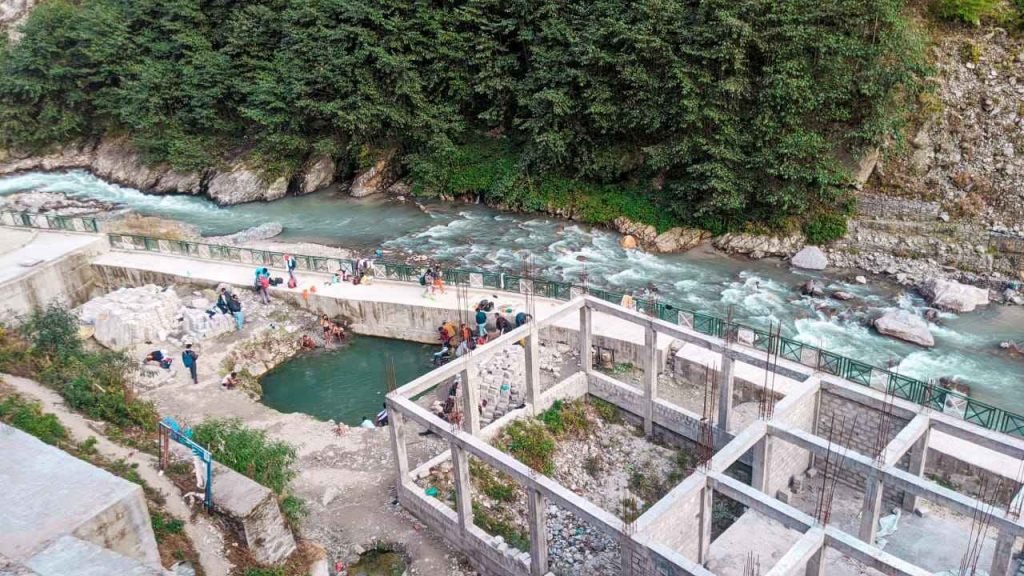
Gaurikund is congested and there are a number of shops catering to all the needs of the travellers. There are a number of accommodation facilities as well at Gaurikund.
We started from Gaurikund at around 8 AM. The Mandakini River was gushing down with beauty and spirit. As much as I wanted to stay there and admire the sprightly river, we had to start our trek towards Kedarnath Temple.
About half a kilometer from the starting gate, is a booking office for horses, mules and palkis and Pitthus. Pitthus are basically men carrying the pilgrims on their back. Usually very old and young pilgrims take the service of Pitthus. There is a fixed rate for mules and Pitthus. You can book them from here. However, you will find mules almost entirely through the trail.

After a kilometer of trekking comes the Horse Point (Ghoda Pul) or the place from where you can get on your horses or mules to carry your journey. The horses are allowed from this point only. Upto this place, the trail is quite crowded with horses, mules and their owners. And don’t you forget, they will constantly ask you to get a mule for the journey! I had been told at least 15 times that I should take a horse to Kedarnath.
We trekked along the well-made trail. As usual, very soon we were quite tired and panting. Our legs were screaming for respite. Well, this is what happens if you are out of any fitness regime and had not trekked for almost a year! Nevertheless, we continued to trek. Though I must admit that there were a couple of moments when I felt that I should have hired a mule.

The next significant stop on the trail is the Bheembali. The trekking route bifurcates at Bheembali – one for the trekkers and the other specially designated for horses and mules. Both the trails finally meet after Rambara.
Rambara was once one of the biggest settlements in the Kedarnath trek route. The floods of 2013 had completely wiped off the settlement. What remains now is the debris of the old trekking route which was pointed to us by a local shopkeeper. It is also here that we see the Mandakini River flowing down with force through the gorges.
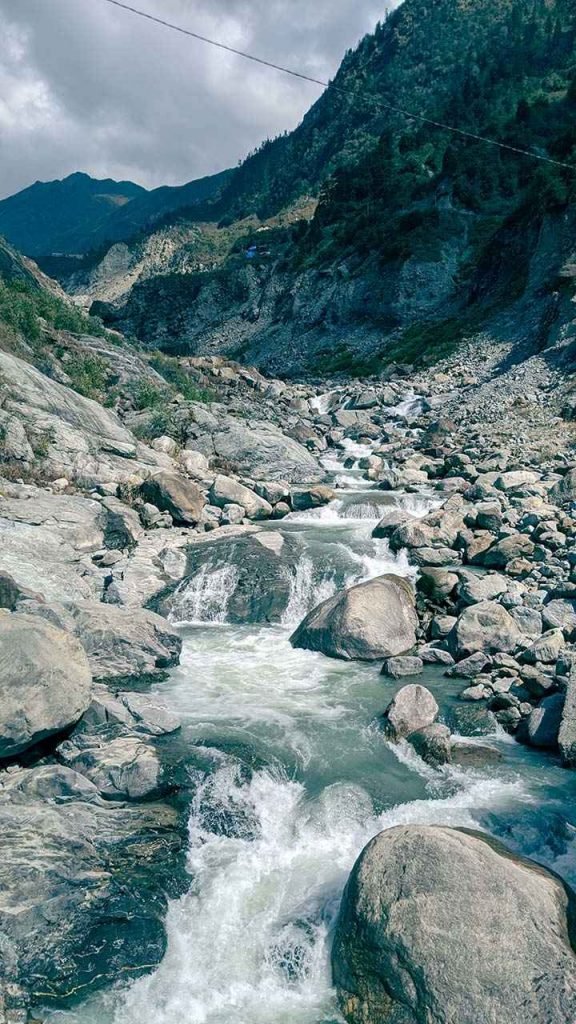
The older route to Kedarnath was through the left of Mandakini River and that route is now completely destroyed. The new route has now been constructed at the right side of the river. A few more minutes of trekking and we reached Chhoti Lincholi. It was almost 12.30 PM at that time and we decided to take a lunch break there. This place can be roughly said to be the midpoint of the trail.

We had a good lunch of alu paratha at Chhoti Lincholi and were quite ready for our next stretch of the trek. And it was then, something sort of a miracle happened. It started snowing! Well, not exactly all the big snowfall, but we could see the snowflakes on the tents and on us.
To be honest, it was a bright and sunny day when we started. The snowfall made all the people quite happy and a group started singing a local song. We were told that it was the second snow of the season and all the locals were quite happy to see the snow. We enjoyed the snowfall for almost half an hour after which it stopped.
The snowfall might have had us gushing like diehard romantics, but it definitely made the trail a bit difficult for us. We were already late for more than an hour and the weather became chilly. It was a lazy start after lunch and snowfall and gradually we trekked our way towards Kedarnath.

Finally, we reached Lincholi. There are a few accommodation options at Lincholi. You can stay here for the night. Kedarnath is about 6 km from Lincholi. As much as we were tempted to stop at Lincholi, we decided to trek all the way to Kedarnath. After trekking for another hour, we reached Kedarnath Base Camp.
There is a GMVN Guest house and cottages at Kedarnath base Camp. Kedarnath shrine is another 500 m from here. There is also a check post here where they check the registration slips. They only ask for the e-pass numbers and really do not check any slips. We trekked towards the shrine and finally we reached there at around 4PM. Once we reached Kedarnath, we tried to look for a place to stay. There are a number of places to stay near the shrine, mostly dormitories. We finally chose to stay at Bikaner House just behind the Kedarnath Temple.
We were quite in time for the evening Aarti at the Kedarnath Temple. The Aarti starts at 5.30 PM. After watching the Aarti, we went to our guest house, had our dinner and simply snuggled into our sleeping bags.
Kedarnath Temple – the end of the trek
We awoke early the next morning and went to visit the Kedarnath Temple. This time we saw the temple in all its glory. The main temple of the Kedarnath remained unscathed in the floods of 2013.
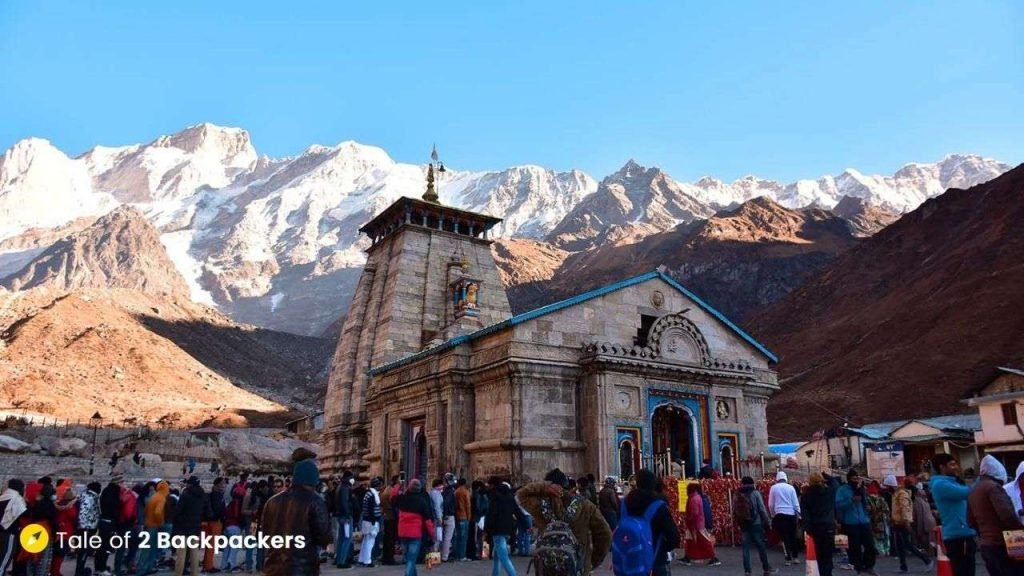
The interior of the temple is a bit dark. There are statues of the five Pandava brothers and Draupadi, their consort. Inside the main hall, there is a conical shaped stone that is said to be the hump of the bull that Lord Shiva transformed into (remember the story I mentioned before). There are statues of Lord Shiva and a few other deities inside the main hall as well.
We offered our prayers in the temple and then roamed around the place for some time. I had a few old pictures when I had visited Kedarnath Temple almost 3 decades back. I tried to connect the places with that of those pictures. Obviously, the place had changed, but the temple had remained intact.

Outside the temple, there is a statue of Nandi, the bull facing the temple. The entire place looks quite beautiful with the snow-covered Kedarnath peak (6940 m or 22,769 ft), the Kedar Dome (6,831 m 22,411 ft) and other peaks surrounding the temple on three sides.
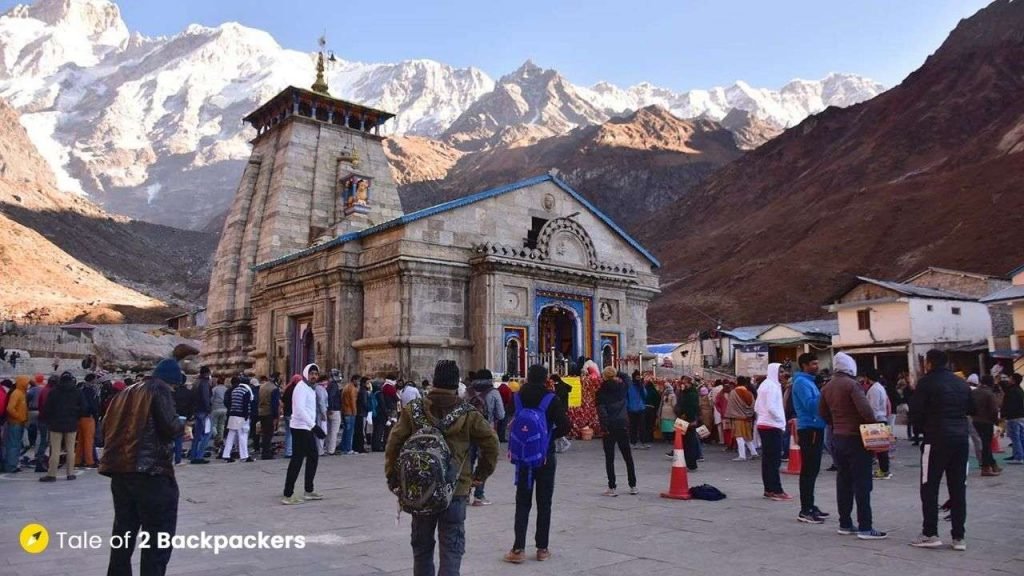
Just behind the temple is a huge rock known as the Shri Divya Bheem Shila. It is believed that this stone had protected the temple from the waters of the flood in 2013. When the waters of Gandhi Sarovar carried large chunks of moraines and stones, this huge stone boulder tumbled down and anchored just behind the temple. This rock then diverted the flow of water to the sides and the temple remained intact.

You will invariably feel calmness at this place. All around the temple, you will see many ash-smeared saints and sadhus sitting with a trident (Trishul). They seem to be in a world of their own. It is quite interesting to see these sadhus all around the temple, sometimes singing while at other times having a pot of marijuana.

After spending some time around the Kedarnath Temple, we started our return journey towards Gaurikund at around 8.30 AM. We descended to Gaurikund after taking occasional breaks and reached there by 2 PM. Our car had been waiting for us at Gaurikund. We continued our journey towards Guptkashi and decided to stop there for the night before continuing our journey towards Badrinath. Our visit to Badrinath remains for the next story.
Kedarnath Temple Timings:
The temple remains open from 4 AM to 9 PM everyday.
All that you need to know about Kedarnath Trek and Yatra
How to Reach Kedarnath?
Jolly Grant Airport near Dehradun is the nearest airport and is located about 235 km from Kedarnath. Taxis are available from the airport to Sonprayag.
The nearest railway station to Kedarnath is Haridwar or Rishikesh. From Haridwar and rishikesh, you will get direct buses to Guptkashi and Sonprayag. But these buses are few in number. You can check online bus sites to see the time of the buses. Buses to Guptkashi, Karnaprayag, Gopeshwar are now available from Delhi (ISBT) as well.
You can also hire a car to reach Guptkashi or Sonprayag. However, it is better to book a car for both Kedarnath and Badrinath or the entire Char Dham Package. The cars charge a lot more if you only ask them to drop at Sonprayag.

We had hired a car for 5 days to visit Kedarnath and Badrinath and it cost us about INR 11,000 for the 5 days (which I do consider to be cheap). We also stopped at Tungnath and Chopta on the way from Kedarnath to Badrinath.
If you are driving by your own car, you can follow the route:
Haridwar – Rishikesh – Pipalkoti – Devprayag – Srinagar – Rudraprayag – Agastamuni – Guptkashi – Phata – Sonprayag
Sonprayag has a huge parking space where you can keep your car for the night. The Registration centre for the yatra is just a few metres ahead of the parking space.
The distance between Sonprayag and Gaurikund is about 5 km. You can start the trek from Sonprayag or else take the shared jeeps to Gaurikund. The jeep fare is INR 30 per head. The stretch of road from Sonprayag to Gaurikund is quite bumpy and rough.
Gaurikund serves as the base camp for the Kedarnath trek.
From Gaurikund, you can either trek or ride horses/mules to Kedarnath.
Kedarnath on foot (Kedarnath Trek)
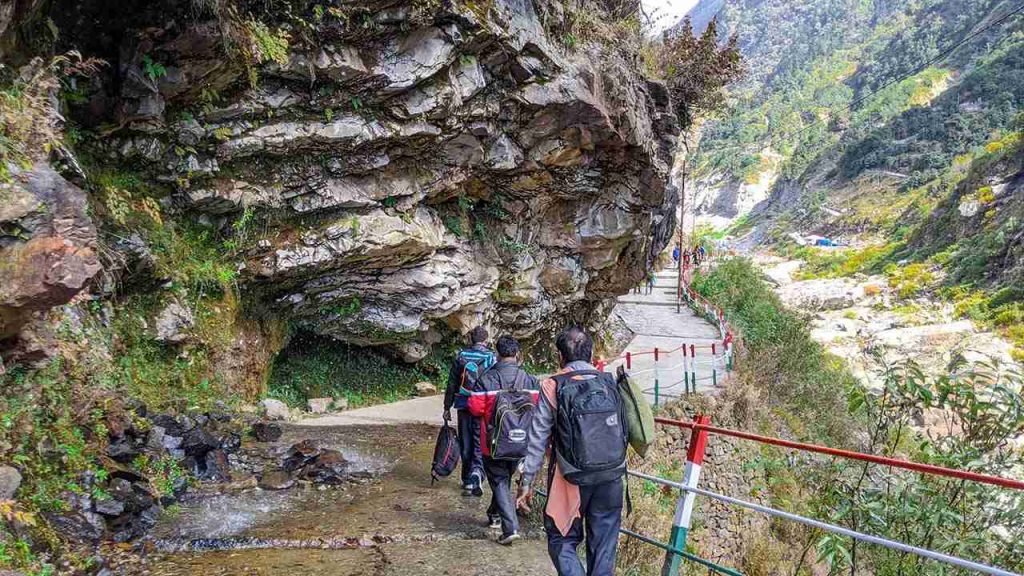
The total trekking distance from Gaurikund to Kedarnath Temple is about 16-17 km.
Kedarnath Trek Route
- Gaurikund – Jungle Chatti (4 km)
- Jungle Chatti – Bheembali (3 km)
- Bheembali – Lincholi (4 km)
- Lincholi – Kedarnath base camp (4 km)
- Kedarnath base camp – Kedarnath temple (1 km)
The entire trail can be covered in a single day on foot. There are a few accommodation facilities in the middle.
Kedarnath by Horses/ Mules and Pitthus
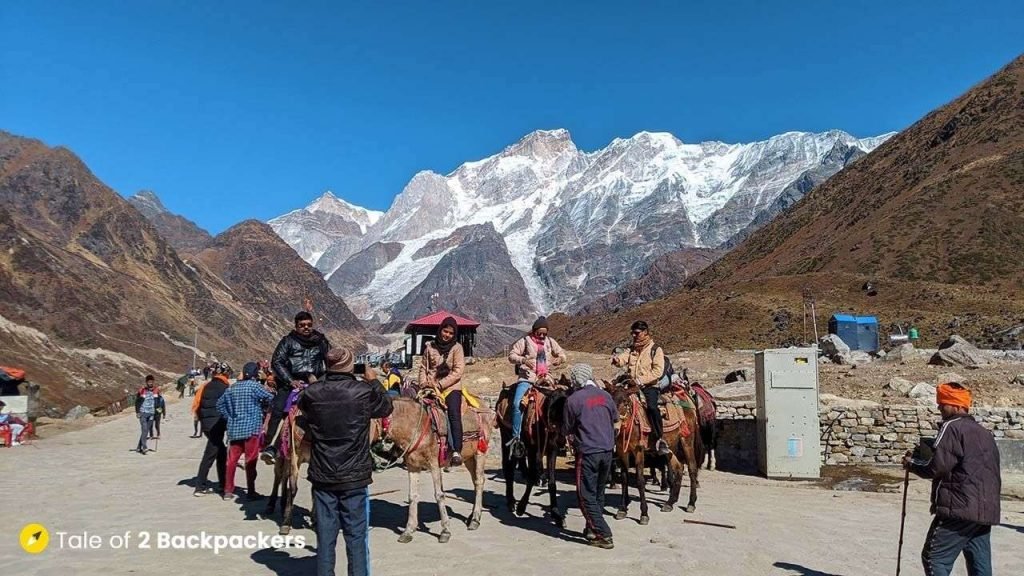
Horses, palkis, kandis and Pitthus are available from Gaurikund to Kedarnath. There is a booking office just before the starting point of the trek from where you can get them. There is a fixed rate for horses and mules. The rate for pitthus and kandis vary with weight. While you will get them easily at Gaurikund, you will also get them on the way.
Tip on riding horses/mules: Bend forward while climbing upward and bend backward while climbing down and hold the saddle tightly.
Kedarnath by Helicopter

These days many people travel to Kedarnath by helicopter as well. The helipad is at Phata located between Guptkashi and Sonprayag. We found a couple of different operators providing helicopter services to Kedarnath. While Phata is the main place from where you can get helicopter rides, other helipads are found at Sersi and Sitapur. The helicopter would take you to Kedarnath Base Camp, about 1 km from the Kedarnath Temple. This distance has to be covered by foot. Even horses are not allowed beyond a certain point.
Things to remember for Helicopter ride to Kedarnath
- The helipads are at Phata, Sersi and Sitapur.
- Only 2 kg of luggage is allowed per person.
- Additional charges are levied if you weigh more than 80 kg and above 120 kg, 2 seats need to be booked.
- The price of the tickets depends on the helipad you are flying from. Usually a round trip cost somewhere between INR 5000 to 7000.
- If you get the round trip ticket for the same day, then they usually allot 2 hours to visit the temple and come back to the helipad.
- It takes roughly around 10 minutes to fly to Kedarnath Base Helipad and from there it is an easy trek of 15-20 minutes to the Kedarnath Temple.
- Helicopter services might stop at any time due to bad weather conditions.
Where to stay at Kedarnath?
There are plenty of hotels and guest houses at Sonprayag as well as Gaurikund. GMVN Guest Houses are also available and you can book them online.
GMVN Guest House and cottages are also available at Kedarnath Base Camp. There are a number of guest houses and dormitories available near the temple as well. We stayed at Bikaner Bhawan just behind the temple.
Accommodation options are also available on the way to Kedarnath. GMVN Guest Houses are available at Jungle Chatti, Bheemabali and Lincholi. Online booking is available at these guest houses and I would recommend you to book them beforehand if you opt to stay in between.
We stayed at Bikaner Bhawan in a double-bed room which cost INR 2000. Hot water is also available and a bucket would cost you around INR 60 – 70.
The rates of the guesthouses and hotels near the Kedarnath temple can change randomly. We would recommend you to book your stay beforehand if you are visiting with family.

Medical facilities on Kedarnath Trek
Medical centres and facilities are available throughout the way. You can find them in between Jungle Chatti, Bheemabali and Lincholi.
Food, Drinks, Shops and Restaurants on Kedarnath Trek
Most of the hotels, guest houses and GMVN Guest Houses provide food at reasonable prices. The food available is vegetarian and quite tasty. There are many shops available all through the trek route selling Maggi, parathas, snacks and hot beverages. You will definitely not go hungry on your trek to Kedarnath.
Toilet Facilities on Kedarnath Trek
Make-shift toilet tents are available on the way at various places in the trekking route.
Is there Mobile and Internet Service at Kedarnath?
Mobile services are available at Gaurikund till Lincholi. However, it is a bit rough at Kedarnath. We found Jio and Airtel services at Kedarnath while there was no mobile service for Vodafone.
Free wifi is available at the main areas like Jungle Chatti, Bheemabali, Lincholi and Kedarnath. However, do not rely much on the free wifi services. We did not get any during our stay at Kedarnath.

When is the best time to visit Kedarnath Temple?
Kedarnath is a part of the Char Dham Yatra. The temple opens on the auspicious day of Akshay Tritiya (usually falls in April or May) and closes on the day of Bhai Dooj (falls in October or November). Kedarnath Dham can only be visited during this time.
Kedarnath is located at an altitude of 3553 m and remains cold most of the time. The weather is quite unpredictable in the mountains. Usually May to June and October to November is a good time for Kedarnath Trek. July to September are the monsoon months and there are chances for landslides during this time.

Places around the Kedarnath Temple
Bhaironath Temple
This temple is located at a very short distance from the Kedarnath Temple. It is believed that Bhaironath guards the Kedarnath Temple by keeping the evil at bay.
Shankaracharya Samadhi
This is the resting place of Adi Shankaracharya and is located near the Kedarnath Temple.
Gandhi Sarovar
About 3 km from Kedarnath Temple lies the Gandhi Sarovar that is fed by the Chorabari Glacier. If you wish to trek there, start early in the morning. The weather can change quite abruptly.
Vasuki Tal
Vasuki Tal is located about 8 km from Kedarnath Temple. The trekking trail is quite steep and should be done with the help of guides. The Vasuki Taal offers a great view of the Chaukhamba ranges.
Rudra Meditation Cave
This is an interesting place. Located about 1.5 km from the temple, there is an underground cave available for meditation and isolation. The caves have a window that provides a direct view of the Kedarnath Temple. You can book the cave for yourself for the purpose of meditation for a maximum of 3 days. Obviously, only one person can stay inside the cave. The cave has all living facilities like water, electricity, heater, attached toilet and a phone to call the authorities in case of emergency.

Some interesting Facts about the Kedarnath Temple
- It is believed that the Kedarnath Temple is eternally protected and cannot be harmed.
- Bhaironath Ji is the protector of the Kedarnath Temple and is known as the Kshetrapal. He is the fiery avatar of Lord Shiva and is known for devastation and destruction.
- Kedarnath is one of the 12 Jyotirlings of Lord Shiva. It is infact, the highest of all the Jyotirlings in India.
- After Bhai Dooj, when the temple is closed, the main deity is brought down to Ukhimath.
- The head priest of the Kedarnath Temple belongs to the Veerashaiva community of Karnataka and is known as Rawal. However, the head priest or Rawal does not conduct the ritual inside the temple. He only gives instructions to his assistants. The deity is transferred to Ukhimath during the winter. The puja is performed in Kannada language.
- The temple is said to have been buried under ice for almost 400 years.

Have you visited Kedarnath? Please let us know your thoughts on this famous pilgrimage. If you liked this post and found it helpful, please share it with your family, friends and neighbours!
Pin it for a later read!








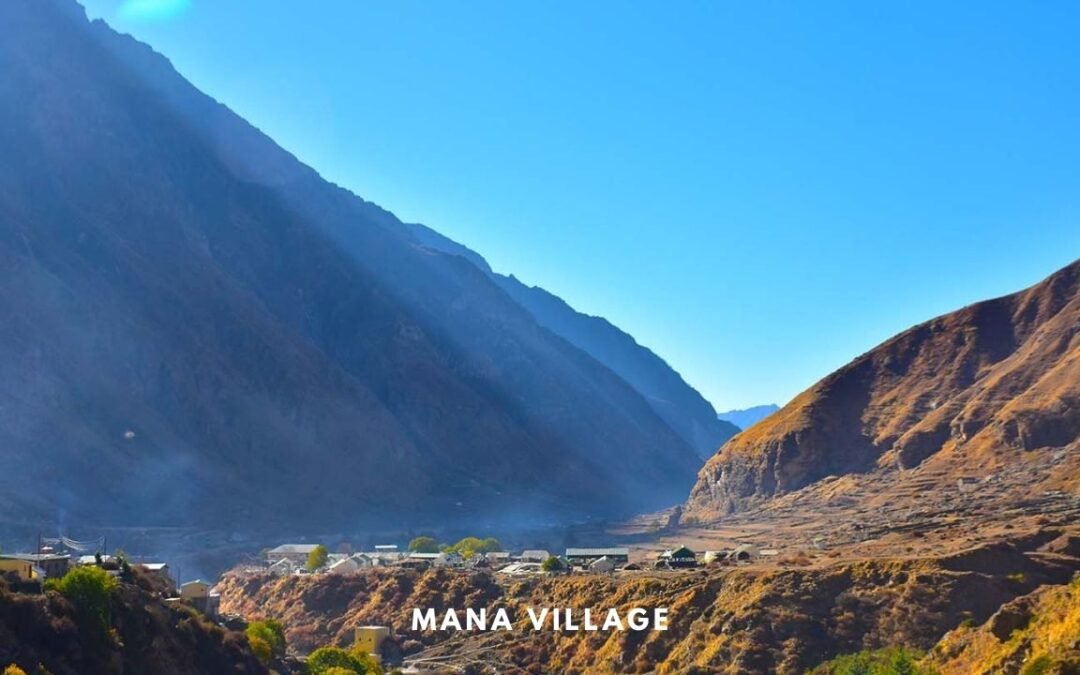
Descriptive blog about Kedarnath, valuable info shared for first-time travelers. Trekking in Kedarnath is an exciting and adventurous journey where you can avail all the accommodation as well as camping facilities with an awestruck top view from hills. Worth visiting along the trails to experience the local life.
Thank you!
This is by far the most amazing blog I found on Kedarnath yatra. All the information is quite helpful. I almost felt that I am right there with you on the trek.Thanks for writing.
Thank you so much, for your kind words.
I never heard of the Kedarnath and after this in-depth description and experience, I would love to do a trek here. I love a hike with beautiful mountains and culture combined and this has it. The backdrop to the temple is truly amazing and I would just go to the temple just to see that. A lot of information here to consider as well, so I have bookmarked this page as I hope to do some hiking in India once Covid clears off. This part of the world has been on my list for a long time.
Thank you Danik! Kedarnath is one of the spiritual places in India and is absolutely gorgeous.
Wow just look at those mountains. I would love to do this hike and when I visit India I need a long time to see the beautiful places in this country. This looks like a great 2 day and worth it and the views must be amazing during the whole trek. I hope I get to visit one day as it looks amazing.
That I totally agree to. You will need a lot of time to explore India! Thank you for the lovely comment!
This is a great comprehensive guide! We have never heard of Kedarnath Yatra, but it looks like an interesting place to discover. Spiritual, historic and hiking all in one trip? That sounds like our kind of thing. We’ll definitely include this in our India itinerary when it’s safe to travel.
Thank you so much!
What a fantastic experience! You provided so much information about Kedarnath, I feel like I could go and have a good idea of what to expect. I think the Kedarnath Trek sounds fascinating, although it must have been tiring the cultural experience and natural views must have been worth it.
Thank you Chloe! Kedarnath trek is quite an experience.
So interesting to read about the Kedarnath Yatra pilgrimage. And great to return to a trek that brings back special family memories. I can certainly see why the scenery along the river way to the start of your trek intrigued you. It looks like an interesting trek up to the Kedarnath Temple. Even if there was snow along the way. I might want to visit by helicopter and see those amazing views from above.
Helicopter ride is a good way to reach the place for those who cannot hike. Thank you Linda for the lovely comment!
What a great travel story and also a guide for those who want to do this trek. The views are absolutely breathtaking! And I love all those hidden little stories you mentioned. This trip also get a very personal feeling as other family members told you all those stories. The temples are all beautiful.
Thank you so much, Paula!
Oh my God! I am bookmarking this post. Kedarnath has been on the top of my list. I want to hike and visit this amazing place, especially to hike. And also take my mother as she loves these kinds of religious places even though I would send her to the temple by other means and not by hiking. Thanks for this post, I will try to visit it as soon as the pandemic is over.
Thank you, Raksha! I am sure you will love Kedarnath.
I’m hoping to go on Kedarnath Yatra after a couple of years. Good to know that they trek is about 16-17km and can be done in a day and there are also some accommodations on the way.
Hahaha, it is funny and awesome that you visited Kedarnath as a kid and now your dad managed to give all the embarassing details to Agni. Now that I travel with my toddler, I have quite a bit of such funny and embarassing moments. Hoping to pass it on to her partner in future… Am I evil? Hahaha..
I bet you are! Just imagine my embarrassment when my dad gave all my secrets to my hubby. And he teases me with those till date!
I felt as if I were doing the trek with you as I read this. Beautifully covered with useful tips within. I have been meaning to get here and now am even more tempted. Loved your pics of the Sonprayag and the various trekking spots. The history and legends around this place really make it special. I knew the bit about Mahabharat and Shankracharya but did not know about how it was discovered
Thank you so much, Ami!
Amazing Blog, Thank for sharing this wonderful website with us.
Thank you so much!
this is a great read, very engaging and informative.
I have a quick question regarding the stay at Kedarnath, you mentioned your stay at Bikaner house, is there any way to pre-book it?
Thank you so much for the comment. I think the stay at Bikaner House can be pre-booked. Please try calling +91-8191900012.
Hi, How can we book hotels near the temple in Kedarnath? You mentioned that it’s better if done ahead of the travel?
Can it be done online?
There are a few websites from where you can find out the contact numbers of the hotels near Kedarnath Temple. But I doubt whether it can be done online. There are also a number of travel agents in Haridwar and Rishikesh from where you can get your stay. Thank you for stopping by our blog. Keep reading!
One of my biggest dreams is to go to Kedarnath and in this blog, I got all the information for my next trip. And all the images are extremely beautiful. Thank you so much for sharing all this wonderful info with us.
Thank you so much Shivani! We are so glad you liked our blog.
Good Luck for the upcoming update.This article is really very interesting.
Amazing Blog… many things to learn. thanks for sharing.
Thank you!
It’s amazing blog and very informative about Kedarnath trek….. This blog will very helpfull for newbies.
Nice Blog…. This is really amazing. Great information about Kedarnath trek.
Thank you so much!
Woooow so nicely explain every minute details. This will help us a lot for sure for our planning.
Thank you so much!
Thank you for a very informative write up. One question, how long did it take you to trek back to Gaurikund? You mentioned you reached at 12.30, but not state the start time. Did you have time to look around in the morning before starting the trek back?
Hello Sharmila! Thank you for reading our blog! And thank you also for pointing out the time. We had reached Gaurikund by 2PM and not 12PM. It was typo error. Now we have corrected it. We had started around 8.30AM after attending the morning aarti and just roaming around the place.
Hi… felt like a movie … scenes passes thru my imaginative mind! Clear cut, lively explanation.
I am visiting kedar, badri and tungnath this June. Plz help me with a trustable travel agency or travel agents number. We are from bangalore and will come thru flight.
Thanks a lot I. Advance. I am inspired to write a page later.. ( in my son’s notebook.. not here 😉 ) ha ha.
Will be waiting for the reply
Wonderfully done article..Pretty complete.
I am planning to do the Kedar trek with kids 7&12 and planning to rent a car.
You have mentioned you rented a car for 5 days. Does it come with a driver or you drive on your own. Any preferred rental companies for Car?
We had rented a car with driver. We got the car from a rental service at Haridwar. It was near Haridwar Railway Station. Have a wonderful trip to Kedarnath.
Thankyou for the amazing informative content on kedarnath yatra. Everybody needs this informative content keep sharing.
thank you for such a nice, elaborate and interesting blog!! while we have been aspiring to visit Kedarnath and badrinath much in recent times, i was actually looking for a visitor’s experience and just came across yours… thank you once again.
Thank you poorna for the kind words.
Hi. Its very interesting to hear from you. Congratulation for the trek. Now I booked at gourikund . Can you provide any information the proceedings before start trek from Gourikund. Thanks again.
Thank you so much for your comment. Have a great trip and let us know how it went.
A captivating tale of the Kedarnath trek!
The personal experiences you share make it feel like we’re trekking right alongside you.
The spiritual and natural beauty of the region shines through your words. Thanks for taking us on this unforgettable adventure through your storytelling – it’s both inspiring and informative
Thank you so much for your kind words.
Very comprehensive and informative! I think these tips and advice are much helpful. Good you explained everything in detail it has been a great help.
Thank you!
Hi, beautiful article, wish had come across your article before, just couple of days back we trekked to kedarnath, myself 55 yrs old and my husband 58 yrs.
It was dream come true for me at this age, can you with your rich experience share how to treat aching legs after trek. We use coconut oil, is there any other thing which can be of help.
Thankyou. God bless both of you
Hello Ma’am! We are so glad to hear that you had trekked to Kedarnath. Time and again it os proved that age is just a number!
As for treating aching legs, we recommend to apply ice pack on the aching area. It will help a lot. Also keep your legs elevated for few minutes every day. Hope this helps!
Beautiful content and very informative 🙂
Har har mahadev 🙏🏼
Thank you so much!
just enough informative for anyone to get a summary of why, what and how of one of the holiest places in Hindu mythology. Exactly what you need when the bucket list is long and time to prepare short, thank you.
Did you carry your sleeping bags or got there with ease?
Hello Nishant! Thanks for your comment. We did not take any sleeping bags weith us. Got it from the stay.